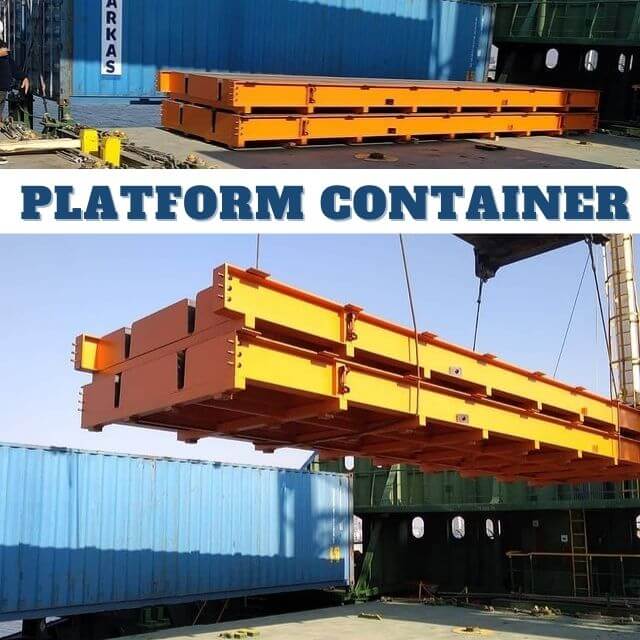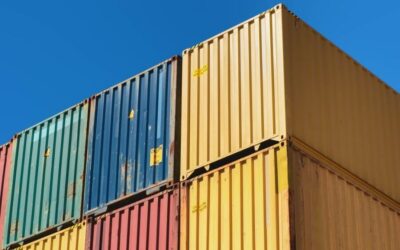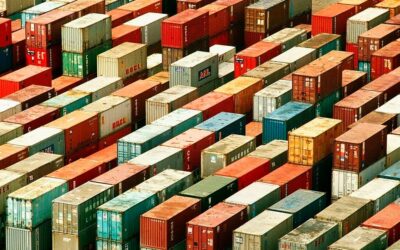Platform Container: An In-Depth Guide
Table of Contents
A platform container is different from a regular container as it has no front and side end walls or a rooftop. This also makes it different from the flat rack containers, which are constructed with front walls.
It is utilized for odd-sized freight which doesn’t fit on or in some other kind of container. Platform container exclusively built with a floor that has a very high freight limit with no side or end walls.
This high loading limit makes it possible to adjust heavy and large cargo in smaller spaces. A platform comprises of a steel outline and a wooden floor structure.
Also Read
| Open Top Container | Hard Top Container |
| Insulated Container | Reefer Container |
| Flat Rack Container | Pallet Wide Containers |
| Intermediate Bulk Container | Ventilated Container |
| Dry Container | Tank Container |
What Makes them Special?
Platform containers are best fit for large, overweight freight and also for cargoes with different shapes which can’t be shipped in other container types including a high cube or open-top holders.
The specially built tough floor is made of a steel framework. This feature combined with the wooden floor gives the appropriate base to heavy and massive load. Due to its huge freight limit, you can likewise put heavy articles on a little surface.
A Platform Container doesn’t have sides, ends and rooftop, which resembles a flat rack. The clients can stack load to platform containers from the side too.
Qualities
There are some characteristics of a platform container that make them distinctive from other containers. They are as follows:
- Hoch Floor development that holds heavy cargo firmly
- No side and front walls
- Steel framework construction and wooden floor
- Gooseneck tunnels
- Introduced lashing rings to make sure about the load
Application
- Ideal for very large and very heavy payload
- Shipping of XXL machines and farm trucks
- Airplane segments
- Stackable
Why Do We Need Platform Container?
If you have to transport freight that has a height that surpasses the stature or width of a typical container, or a cargo that can’t be loaded through the door of a standard container then one of the best-suited options to ship it would be through a platform container.
Platform containers are likewise frequently utilized for things that are excessively heavy for other shipping containers.
In what cases they are used?
Typically, platform containers are utilized to ship products which have a heavyweight on small spaces. Platform containers are additionally helpful to load odd measured freight.
For the most part, the platform containers are utilized to move freight like
- heavy machinery
- oil and gas hardware
- Similar heavyweight gear.
Like other cargo containers, platform containers also conform to ISO standard for local and global transportation.
Gooseneck tunnels and lashing rings:
For simple transportation and movement through the roads, 40′-inch containers have gooseneck tunnels at each end of the container. These breaks permit the container to lie lower and accordingly to have high construction.
For greater security on freight, lashing rings are fixed in the side rails of stage container. These are helpful for the increased freight in a platform container with 40 feet, which has a gooseneck tunnel at the two ends.
In this way, the cargo is to some degree more profound, which is especially valuable for cargo with great heights and can save essential space.
Best Utilization:
All platform containers have fork pocket holes to take better care of the freight. These are pretty much like the flatbed containers in construction design and working. They are basically utilized for heavy or potentially over width cargoes.
A fascinating method of utilizing a platform container is, when laid next to each other on the deck or in the hold of container ships, they can be utilized to move a significantly bigger non-containable load.
Common Heights of Platform Container
Platform containers come in 20ft and 40ft size container and have a strong floor with no end walls or sides.
Though cargo containers come in different sizes and shape yet the most common among them are of 20ft and 40ft containers in the freight industry. Usually, for lighter weight cargo with larger volumes, high cube containers are preferred.
Other container types, for example, flat rack and platform containers are normally used for heavy freight or for large cargo. The particular platform container dimensions and the freight capacity may change depending upon
- The manufacturer of the container
- Its age
- The owner of the container.
The container specifications discussed below are of the most common of the platform containers.
Platform container 20ft
20′ Platform container has internal and external dimensions of 20′ with a volume limit of twenty feet Equipment Unit, tare weight and freight limit of 20′ Platform steel container.
Weight Measurements:
| Tare Weight (kg) | Payload Capacity (kg) |
| 2,740 | 31,260 |
Dimensions:
| Internal Length (m) | Internal Width (m) | Height (m) |
| 6.06 | 2.44 | 2.23 |
Platform Container 40ft
40ft containers have lashing rings to ensure the safety of the freight. The freight that these lashing rings can accommodate can be up to 3,000kg in the side rails and gooseneck tunnels at each end.
Weight measurements:
| Tare Weight (kg) | Payload Capacity (kg) |
| 5,700 | 39,300 |
Dimensions:
| Internal Length (m) | Internal Width (m) | Height (m) |
| 12.19 | 2.44 | 1.95 |
How you can Use Platform Container to Manage Cargo effectively
Platform containers can be lashed together to make a bigger platform for large and heavy loads which are higher than the standard platform container capacity. To load the freight safely and steadily, various lashing rings are attached along the longitudinal bars.
In its base area, a platform container is similar to the standard container in size and has a length of 20 feet or 40 feet. But there are not really any limitations on the size of the freight. The platform container meets all necessities.
A few platforms can even be set one next to the other for storage of goods. We have already read that; the platform container framework is constructed from wood with a steel structure and has an amazingly high loading limit which makes it possible to adjust heavy loads in small spaces.

What can they carry?
They are significantly utilized for transportation of heavy or large load, for example,
- hardware
- Lumber
- Pipes
- Transports
- Boats, and so forth
These items don’t usually fit inside standard containers and stick out through open sides. A go-to decision for freight forwarders, platform containers are incredible for moving substantial freight which is hard to load from the front door.
Some containers even have lashing rings, latching belts, and bolsters giving extra support and security to the cargo.






